One rower, two cats, 900 miles
- Published

Three decades ago, Ove Joensen decided to row 900 miles (1,450km) across the North Sea from his home in the Faroe Islands to Denmark. His persistence made him a national hero.
Nolsoy is a small, remote island that rises sharply from the cold, white waves of the North Atlantic.
Part of the Faroe Islands, which sit between Iceland and Norway, it has one shop, two bars, 213 people, and no cars.
But, in a basement below the tourist information office, it has a wooden boat where a national hero lived and died.
Ove Joensen was born in the Faroes' capital, Torshavn, in 1948. He grew up on Nolsoy, where every house has an ocean view.
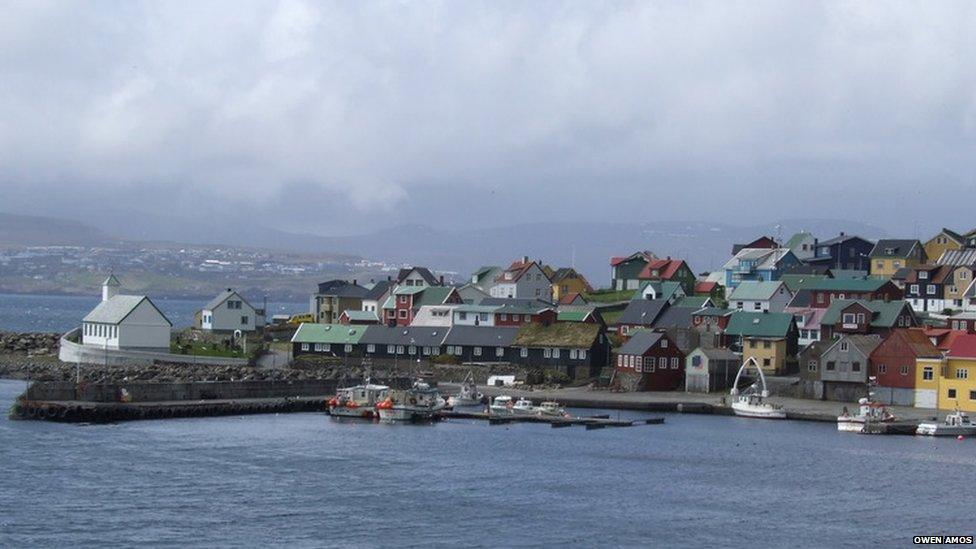
Nolsoy is a 20-minute ferry ride from the Faroese capital, Torshavn
Ove bought his first rowing boat aged 12. Before then, says his cousin Hilmar, he set sail in sliced-up barrels.
"He was always an adventurer," says Hilmar, now 67. "He was very brave in everything he did - climbing the cliffs, rowing in the sea.
"He was sailing from a very young age - we would stay close to the shore and he would be on his way, into the ocean."

Ove Joensen as a boy
As a teenager, Ove worked as a fisherman with his father. Aged 17, he was a chef on a sailing boat; at 27, he worked in the South Pacific with the shipping company Forbes.
It was there, in 1977, that he met Colin Quincey, the New Zealander who changed his life.
That year, Quincey became the first person to row from New Zealand to Australia. In a boat called the Tasman Trespasser, he took 63 days and 7 hours to cover 1,660 miles (2,670km).
For Ove, a seed was planted. In the meantime, there were places to see, people to meet, and adventures to enjoy.
From Greenland to Fiji, Ove worked on ships and saw the world. Like any good sailor, he enjoyed himself when he reached dry land.
There is a picture from 1978 of a grinning Ove playing the accordion on a beach in Fiji, surrounded by wide-eyed locals. A glass of whiskey was probably out of shot.
"Ove was very… alive," says Hilmar, cautiously.
Ove was married once, to Susanne in Denmark in 1976, but it didn't last. He had three children - one with a woman from Fiji.
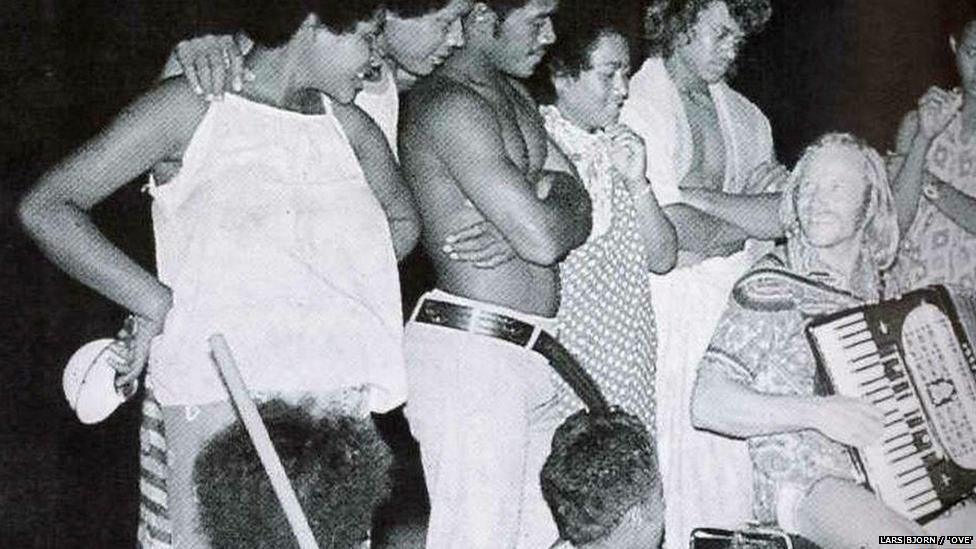
Ove Joensen in Fiji
By 1984, Ove Joensen was ready to make his name. Inspired by Colin Quincey, he decided to become the first person to row the 900 miles from the Faroes to Copenhagen.
He aimed to cover 30 miles a day, and would finish, he said, when he kissed the Little Mermaid.
A customised 20ft boat called the Diana Victoria was built in Torshavn. It had a sleeping compartment (Ove wasn't tall) and room for a month's worth of drinking water, orange juice, and dried meat.
Ove set sail on the 21 July, with only Jessica for company. She was a black and white cat, named after a yacht he worked on in the South Pacific.
"I have to have someone to talk to," said Ove in an interview later. "Someone who is alive."
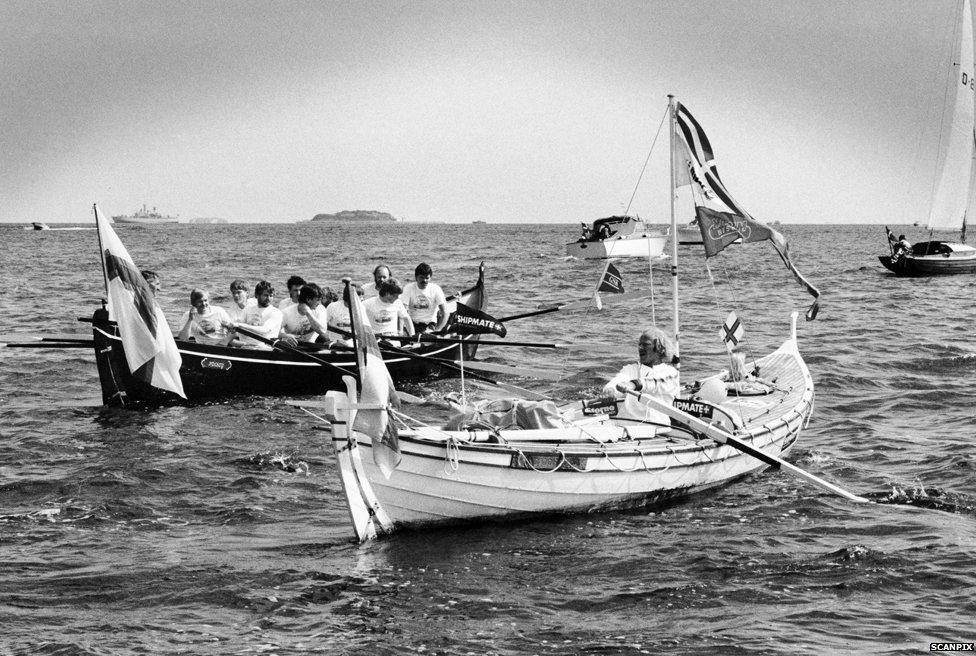
Ove Joensen on his third attempt to reach Copenhagen
A week after setting off, Ove had covered around 150 miles. To help fund the trip, he had an arrangement with a Danish newspaper so, 47 miles west of Shetland, he stopped by a ship to drop off three rolls of film.
After going on board for half an hour to take a call, he returned to find three boards damaged at the stern of the Diana Victoria.
The damage meant that, when Ove dropped his sea anchor to sleep, the boat took on water. Unable to rest, he put his head down, and rowed for land. He covered 46 miles but called for help one mile from Eshaness lighthouse, on the north-west of the Shetland Islands.
According to Kevin Henry, one of the lifeboatmen who rescued him, "He was in a bad way."
"It could have been disastrous," remembers Henry, who's still a mechanic at the lifeboat station in Aith.
"He was absolutely exhausted. The boat was taking on water. He was one mile from the rocks."
The rescue made the front page of the Shetland Times; the picture in the paper showed the lifeboatmen and Ove, with Jessica safely in his arms.
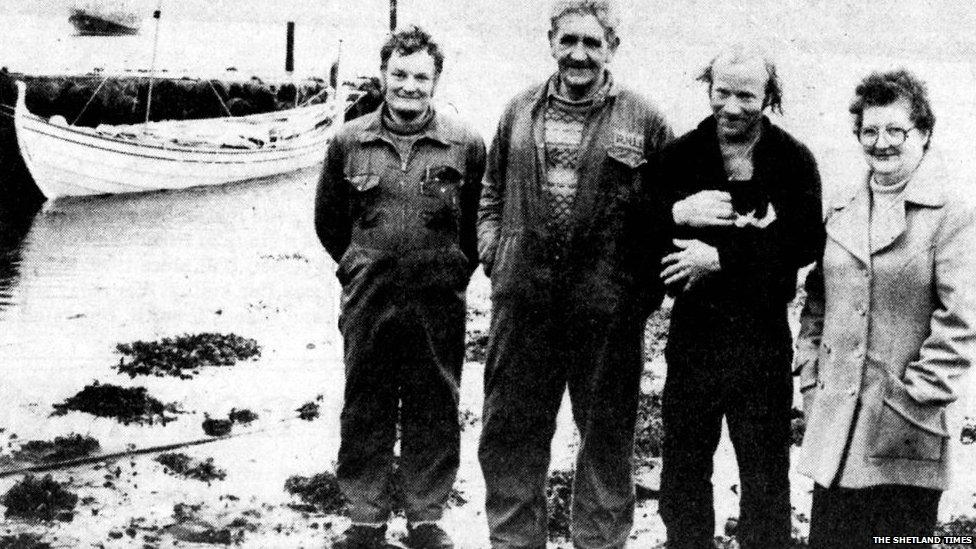
Coxswain Wilbert Clark, James Manson, Ove Joensen holding his cat Jessica, and Carrie Manson in Shetland, 1984
After being rescued, Ove wasn't in a rush to go home. He stayed with another of the lifeboatmen who rescued him, James Manson, and took in what Shetland had to offer.
"He had a good time there," says Hilmar, smiling. "Mainly playing accordion and drinking whisky."
Five weeks after being towed into Aith, Ove and the Diana Victoria headed back to the Faroes on the ferry Norrona. He vowed to try again the next summer.
On 25 July, 1985, Ove set sail from the Faroes once more. Jessica had died, so he took a new cat - Miss Hvannasund, named after the harbour where he had rescued her. One day he had found a man drowning cats in the water there.
The cat, as well as Ove, captured the media's imagination. The Faroese newspaper, Dimmalaetting, printed a cartoon: Miss Hvannasund on the boat, dreaming of a sofa while looking through binoculars, Ove, oars in hand, urging her to be patient.
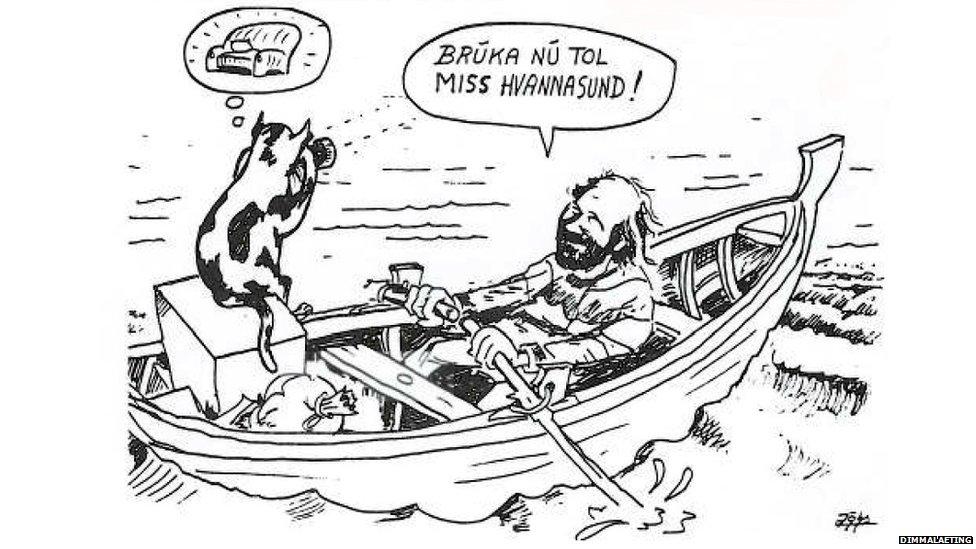
Ove and Miss Hvannasund, as depicted in a Faroese newspaper
She certainly needed to be. Bad weather meant progress was slow. It took Ove two weeks to reach Shetland and, when he did, strong winds meant he called the lifeboat again.
"The second time we rescued him, he was in much better shape," remembers Kevin Henry.
"First time, he was in a poor way. The second time, he could have reached Copenhagen."
The Shetland Times headline - one of the more unlikely in newspaper history - read: "Repeat rescue for Faroese rower and cat."
The story underneath said customs officials barred Miss Hvannasund from coming on shore, so Ove, loyal to the last, spent another night on board to keep her company.

A telegram written by Ove Joensen written from an oil rig near Shetland in 1985
Ove spent more than two weeks on Shetland but, this time, kept moving. He rowed down the west coast, from Aith to Walls to St Ninian's Isle, and waited at Virkie, on the southern tip, for the winds to change.
Unfortunately, they didn't. At least, not to his satisfaction. For the second year in a row, he returned to the Faroes on the ferry, beaten by the challenge he'd set himself.
"He was hurt," remembers Ove's younger brother, Ba. "When he came back in 1985, he was hurting so much. He felt people were talking about him."
Ba, 62, lives in a house on a hillside in Nolsoy. The sound of waves seeps through his windows; reminders of Ove's adventures dot the walls.
"Although he was hurt, he couldn't stay at home," Ba continues. "He was too proud."
So in 1986 Ove tried for a third time. This time he set off from Nolsoy, rather than Torshavn, and - crucially, he thought - left four weeks earlier in the year, in order to beat the weather.
This time, there was no cat. According to his audio diary, on some days his only company was a curious pigeon. To pass the time, he listened to the radio, sometimes the BBC.
With the weather on his side, Ove carved through the water. He passed Shetland after 11 days, Thyboron in western Denmark after 28 days, and Grenaa, on the other side of the country, after 37 days.
Finally, on 11 August - 41 days after setting off, and two years after his first attempt - Ove arrived in Copenhagen, and kissed the Little Mermaid.
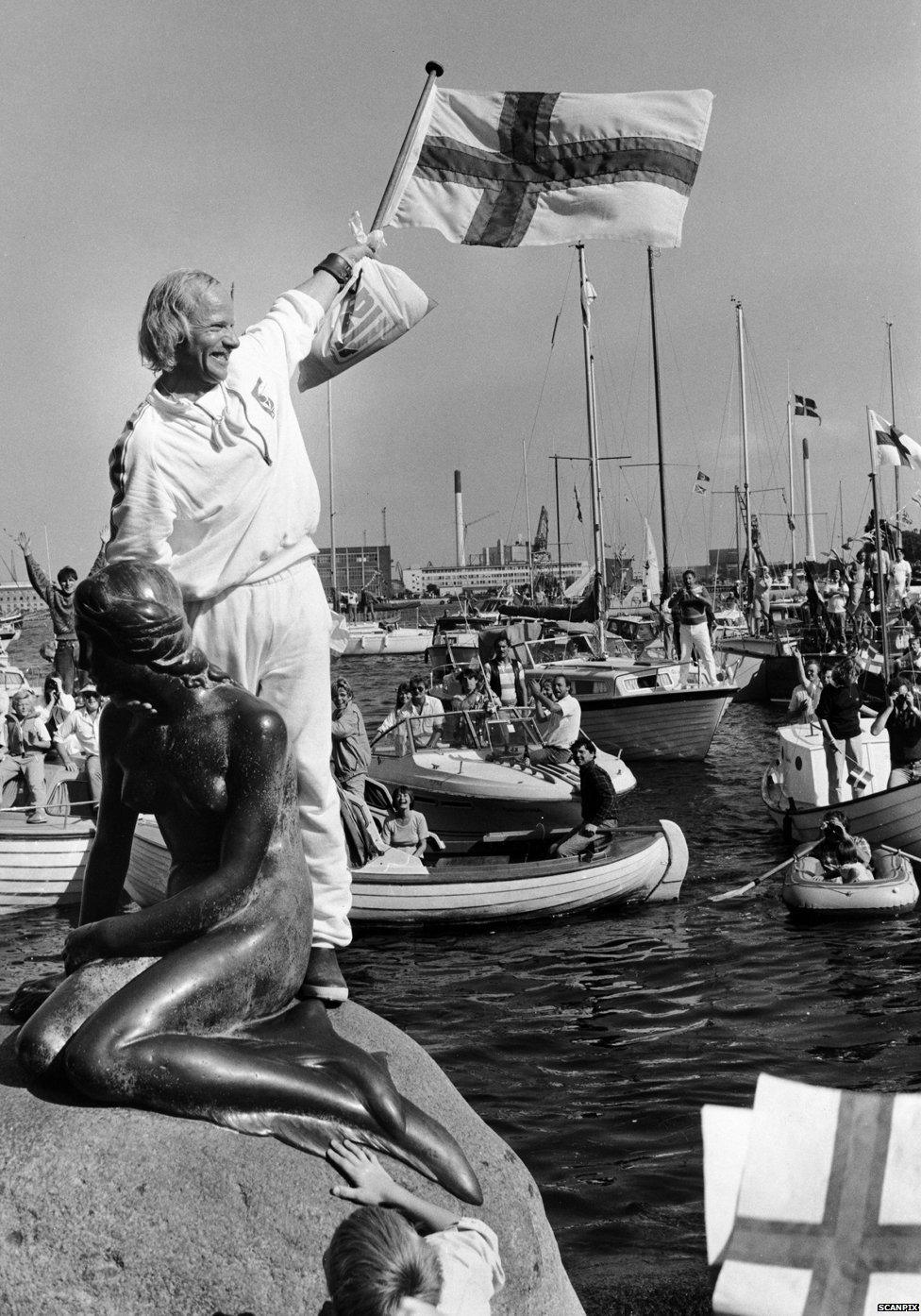
Thousands of people lined the harbour, many of them Faroese expats waving flags. Forty people came from Nolsoy.
The arrival was shown on TV, and Ove - now nicknamed Ro-Ove - was front-page news in Denmark and the Faroes. The Mayor of Copenhagen presented Ove with a 26kg cup, which still sits in the corner of Ba's house.
One of Ove's sponsors - the Danish furniture company, Ide Mobler - gave him a bed.
There was a party at the Admiral Hotel, just south of the Little Mermaid, but the festivities didn't last long. Or - at least - not as long as Ove wanted.
"As part of the deal, Ove had to go from one furniture shop to another," remembers Hilmar. "All over Denmark, day after day, shop after shop. It was crazy.
"At all times, there was someone with him. He wanted a beer but he wasn't allowed. So he got more and more thirsty."
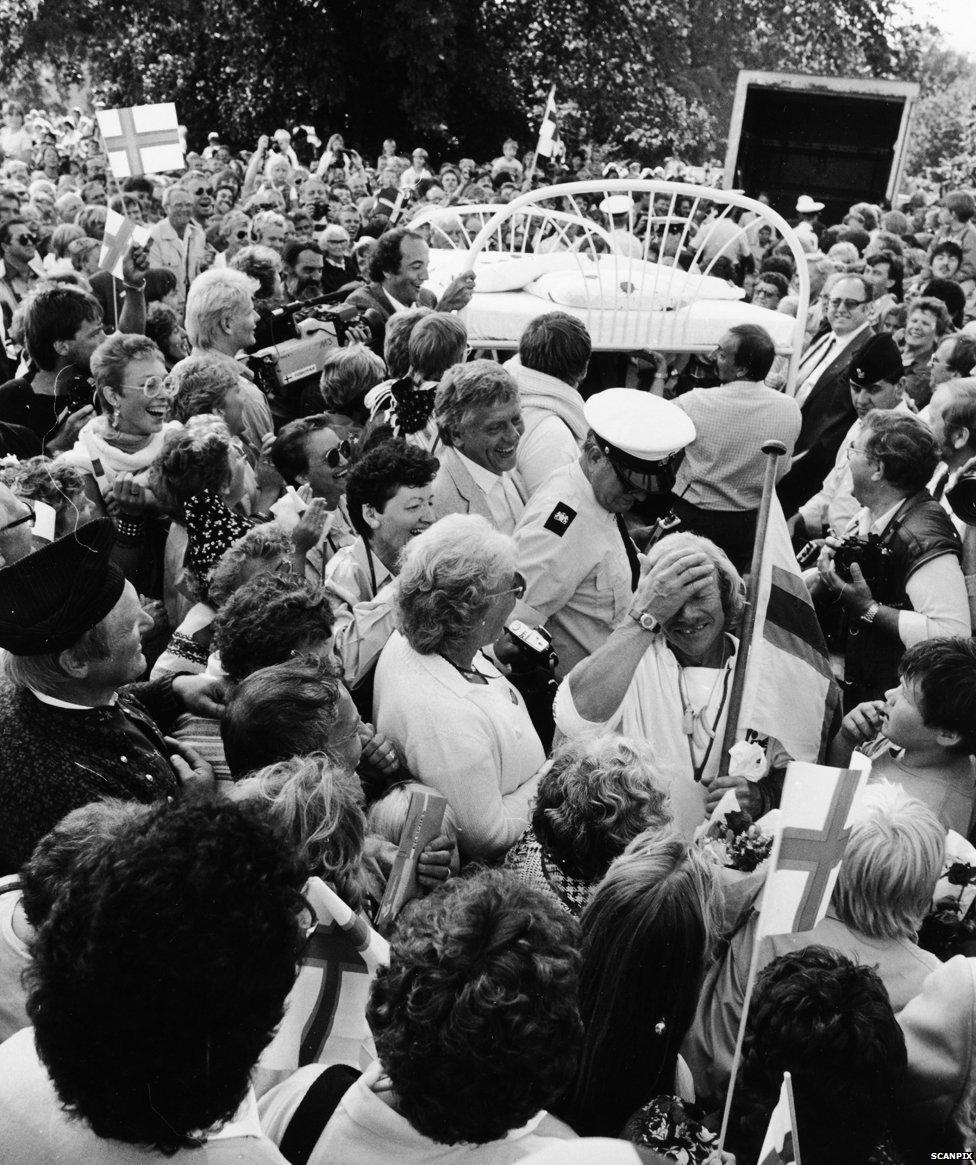
Ove eventually made it back to the Faroes, via the ferry, on 21 September. After a night in Torshavn, he went to Nolsoy, where 2,000 people were waiting for him.
High on success and beer, Ove told the crowd that he'd use his fame - and fortune - to build a swimming pool for Nolsoy. It was, says Hilmar, always unlikely.
"He thought he could make a lot of money, but he wasn't like that," he says.
"He couldn't manage money. If he had something, he would share it with you.
"Such people are vulnerable. That's why he had no money."
What he did have, though, was optimism. At his mother's house in Nolsoy, framed on the wall, there is the report of Ove's homecoming from the Danish newspaper BT.
"I don't have a wife," he told the newspaper, flashing the teeth he had fixed during his tour of Denmark's furniture shops.
"But maybe I will get one tonight."
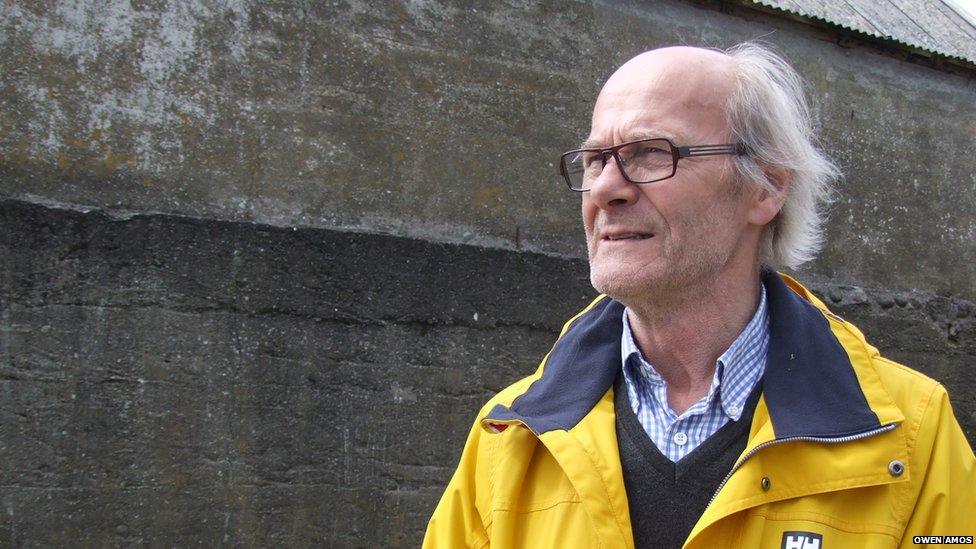
'Such people are vulnerable' Hilmar Joensen remembering his cousin in Nolsoy
After the euphoria, Ove went back to day-to-day life: still sailing, still playing the accordion, still - in Hilmar's words - "alive".
On 24 November 1987, after a night in the Faroese village of Runavik, he decided to row the five miles back to Nolsoy. It was the last journey he made.
Ove's body was found in the water two days later. He was 38.
There was a bruise that suggested he stood up on the boat, slipped, banged his head, and fell unconscious into the ocean.
"He was a strong swimmer, so he must have been unconscious when he hit the water," says Hilmar.
Ove is buried in the small graveyard on the edge of Nolsoy, overlooking the sea.
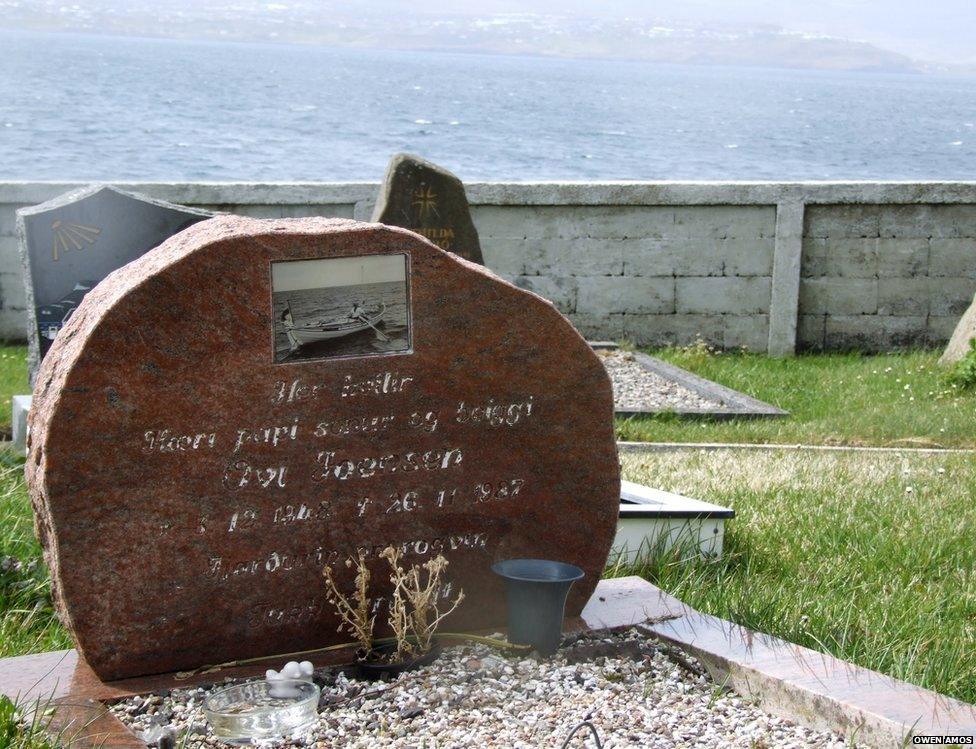
Ove Joensen's grave
By the harbour in Nolsoy, a plaque commemorates Ove's life and achievements. There's also one in Aith, the Scottish village that twice - literally and figuratively - took him in.
In 1999, a choir travelled from the Faroes to Aith to celebrate both Ove, and the bond between two island communities. Ove's niece, Anja, laid a wreath by the plaque.
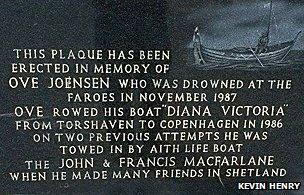
As for the swimming pool, it remains unbuilt. A million krone was raised in Ove's name (about £100,000) through donations, sponsorship, and the sale of books and medallions.
Plans for a ship-shaped pool were drawn up, but, says Hilmar, it was unrealistic for an island of 213 people. "I think we'll build a sports hall instead, and name it after him," he says.
Already, there is a festival in Ove's name on Nolsoy. Held annually in early August, Ovastevna celebrates his life, and raises money for the sports hall.
"There is music, dancing, eating, drinking," says Hilmar. "Ove would have enjoyed it."
In 1986, after the triumphant arrival in Copenhagen, an American offered Ove 2m krone (about £200,000) for his boat. He turned it down.
And so, 29 years on, the Diana Victoria remains below the tourist information office on Nolsoy - a monument to a rower who lived, dreamed, and died on the water.
Subscribe to the BBC News Magazine's email newsletter, external to get articles sent to your inbox.